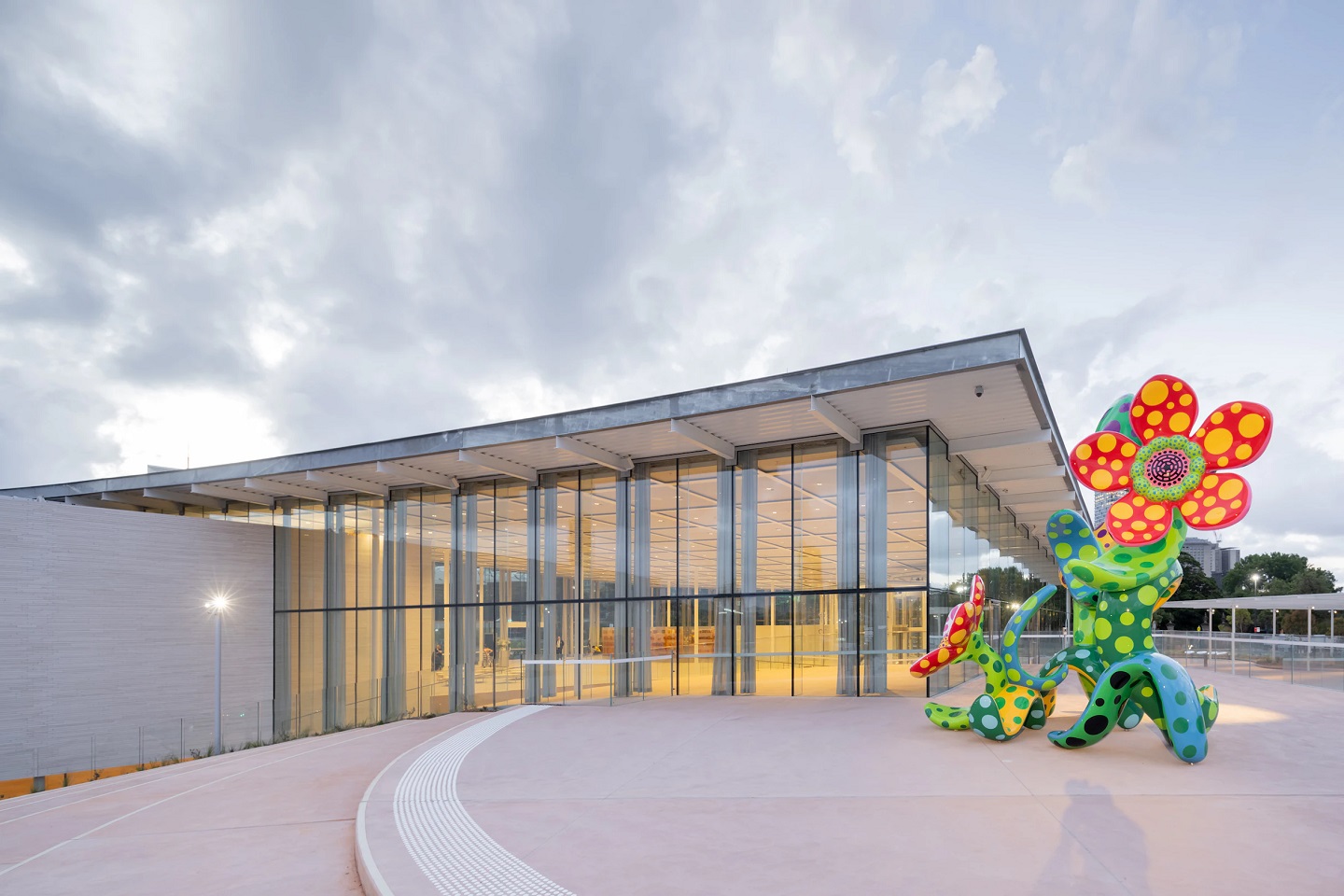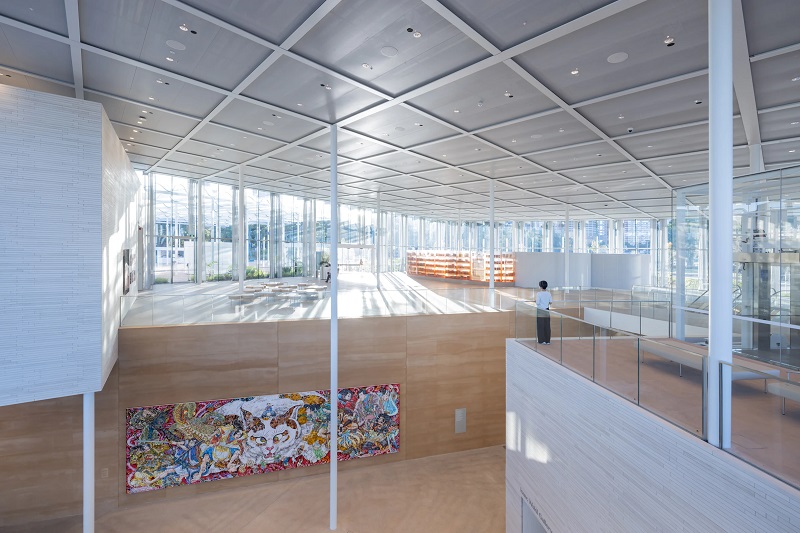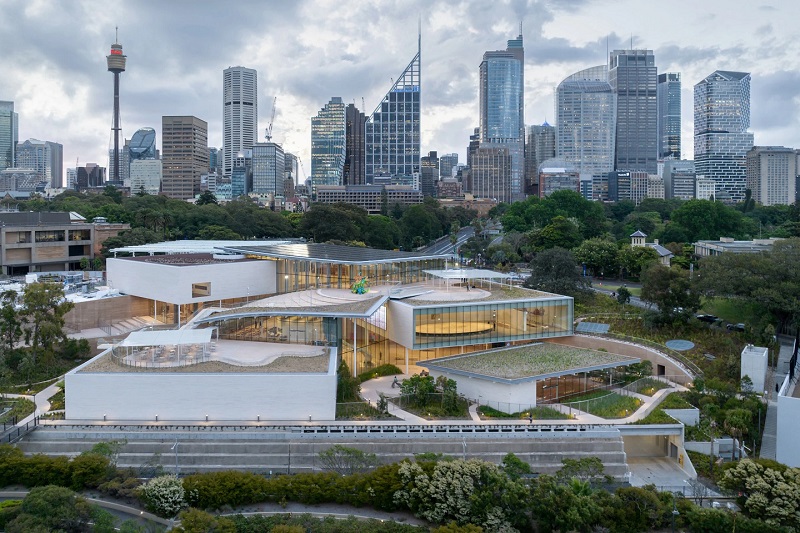
Perched on the North Building’s stepped terrace is a specially commissioned exuberant piece of spotted flowers in signature Yayoi Kusama style (All photos: Iwan Bann)
It has been 50 years since the Jørn Utzon-designed Sydney Opera House was formally opened by the late Queen Elizabeth II. How fitting then that, at end-2022 and just shy of the half-century mark, the vibrant Australian city welcomed yet another cultural and artistic destination in the form of the Sydney Modern Project, a dazzling new standalone structure — simply known as the North Building for now — designed by the Tokyo-based Pritzker Prize-winning duo of Kazuyo Sejima and Ryue Nishizawa of Sanaa.
Although the new wing is meant to complement the South Building, the existing neoclassical 19th-century Art Gallery of New South Wales, both seem a world apart in form and content. Built at a reported cost of A$344 million funded through a public-philanthropic partnership, the results show that the money has been well spent. Environmentalists would surely approve of the country’s first public art museum to receive a 6-star Green Star design rating from the Green Building Council of Australia, the highest environmental standard for design. It is also 100% powered by renewable energy, courtesy of 735 rooftop solar panels that do their part to contribute towards the overall equation.
Planet-friendly facts and figures aside, what makes Sydney Modern truly glow is its unmatchable new collection of Aboriginal and Torres Strait Islander art, all of which take pride of place in the Yiribana Gallery, that acknowledges its location on Gadigal land while its name (meaning “this way”), stems from the Sydney language.
1669956731-art-gallery-nsw-22-11-sanaa-0621px2560.jpg

From Darren Siwes’ 2013 work titled Jingli Kwin, a portrait of an aboriginal couple dressed as sovereign heads of state that subtly challenges the conventions of official portraiture, to Larapinta Valley-based artist Rhonda Sharpe’s Bird with Wings, the thoughtfully curated and exhibited collection highlights the depth and dynamism of indigenous modern Australian art practitioners.
Particular attention must be drawn to Yhonnie Scarce’s Death Zephyr, made up of more than 2,000 hand-blown glass yams suspended in a delicate cloud-like formation. Although beautiful to behold, the glass, nylon and steel installation tells a dark tale, depicting nuclear testing activity conducted in Maralinga in Pitjantjatjara, or Yankunytjatjara Country, sometime between 1953 and 1963. Numerous aboriginal families were exposed to radioactive fallout from this and suffered the aftermath of a lethal cloud they called puyu (poisonous black mist). Scarce, a descendant of the Kokatha and Nukunu people of South Australia, memorialises this loss of lives through her glass yams, each representing an individual, while also showing the devastating effects nuclear testing has on the land, which caused the desert sand to literally melt, encrusting some parts of the surface soil with glass as a result of the bomb blasts’ extreme temperatures.
1669623537-artgallerynsw22-11sanaa1379px2560.jpg

If you need to lighten the mood and reconnect with nature in a healing way, quickly stroll to the beautiful grounds outside where renowned landscape architect Kathryn Gustafson worked to create soothing-to-the-eye green roofs and gardens planted with native Australian species. Oh, and if all that art exploration makes you peckish, top local chef Clayton Wells heads the chic on-site restaurant, which bears the simple, to-the-point name of Mod. Full meals are served as well as all-day brunch, nibbles and small bowls. Start with Sydney rock oysters served with a lemon and marigold dressing before moving on to the spanner crab noodles with charred corn and wood ears in dashi miso. And don’t ever leave without a proper cup of Australian-brewed coffee, best accompanied by the long pepper crème brûlée served with Pedro Ximénez-macerated prunes.
This article first appeared on May 22, 2023 in The Edge Malaysia.


